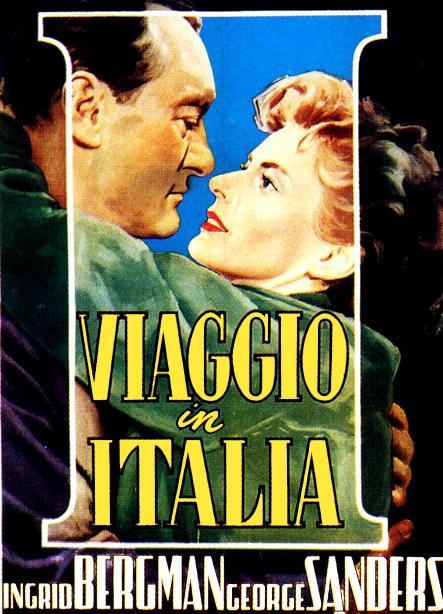Quando Ingrid Bergman deixou Hollywood e um
casamento sólido e escolheu a Itália e um romance com o diretor Roberto
Rossellini, foi um escândalo. Este episódio é tão conhecido dentro da biografia
de Bergman que às vezes os filmes que ela fez com Rossellini são ofuscados pelo
escândalo. Este pequeno conjunto de seis filmes inclui “Stromboli” (1950), a
obra-prima “Europa ‘51” (1952), uma recontagem da história de Joana D’Arc e
esta curiosa “Viagem à Itália”.
When Ingrid Bergman left Hollywood and a solid marriage and chose Italy and a romance with director Roberto Rossellini, it was a scandal. This episode is so well-known inside Bergman’s biography that sometimes the movies she did with Rossellini are obfuscated by the scandal. This little oeuvre of six films includes “Stromboli” (1950), the masterpiece “Europa ‘51” (1952), a re-telling of Joan of Arc’s story and this curious “Journey to Italy”.
Esta é a história da primeira vez em que o
casal Katherine (Ingrid Bergman) e Alex (George Sanders) fica sozinho de
verdade desde que se casaram. Eles estão na Itália por causa de uma herança,
mas não ficarão sozinhos por muito tempo, pois encontram velhos conhecidos e
fazem novas amizades em jantares nos quais ambos desaprovam que o outro se
divirta com outras pessoas. Entre as ruínas eles discutem e parecem chegar a um
ponto de virada no relacionamento.
This is the story of the first time the couple Katherine (Ingrid
Bergman) and Alex (George Sanders) is truly alone ever since they got married.
They are in Italy because of an inheritance, but they won’t stay alone for
long, as they meet old acquaintances and make new friends in dinners where both
dislike that the other has fun with other people. Among the ruins, they have
their arguments and seem to arrive at a crossroads in their relationship.
Quando Katherine visita um museu na primeira
metade do filme, as peças em exibição são oriundas de Pompeia. A tragédia da
cidade tomada pelo vulcão séculos atrás assombra o casal, pois a vila que
herdaram tem como vista o Vesúvio. Ao voltar do museu, ela conta sua
experiência, dizendo que foi como se ela pudesse sentir como estas pessoas,
imortalizadas em estátuas, eram e o que elas queriam.
When Katherine visits a museum in the first half of the film,
the pieces there are remains from Pompeii. The tragedy of the city engulfed by
the volcano centuries ago lingers on the couple, as the villa they inherited
has the Vesuvius as a view. After coming back from the museum, she chronicles
her experiences, saying that it was as if she could sense how those people immortalized
in statues were like and what they wanted.
Embora não creditada, a fonte para o filme foi
uma novela chamada “Duo”, da escritora Colette. Rossellini, junto com Vitaliano
Brancati, escreveu o roteiro. George Sanders escreveu em sua autobiografia que
rodar o filme foi uma experiência desesperadora, que ele realmente detestou.
Talvez tenha sido porque este é um filme feito por um Rossellini em mutação: o
diretor / roteirista / produtor estava abandonado o Neorrealismo e se comprometendo
com um novo tipo de Realismo. O método de trabalho de Rossellini –
especialmente o fato de ele trabalhar sem um roteiro – também desagradaram a
Sanders.
Although uncredited, the source of the film was a novel
called “Duo” by writer Colette. Rossellini, together with Vitaliano Brancati,
wrote the screenplay. George Sanders wrote in his autobiography that shooting
the film was an exasperating experience, one he truly disliked. Maybe it was
because this is a movie made by a changing Rossellini: the director / writer /
producer was abandoning the Neo-Realism and committing to a new kind of
Realism. Rossellini’s work methods – especially working without a script – also
displeased Sanders.
Em 1953, quando o filme começou a ser rodado, Bergman
e Rossellini, como um casal, estavam em crise. O diretor também atravessava uma
crise financeira – ele só conseguiu financiamento para o filme através de um
industrial milanês que era seu fã. Quando as filmagens terminaram, Rossellini
demorou mais um ano e meio para conseguir um distribuidor para o filme, que foi
um fracasso de bilheteria e só agradou aos críticos da Cahiers du Cinéma –
aqueles jovens que revolucionariam o cinema com a Nouvelle Vague alguns anos
mais tarde.
In 1953, when the movie started shooting, Bergman and
Rossellini, as a couple, were struggling. The director was also struggling
financially – he could only get financing for the movie through a Milanese
industrialist who was his fan. When filming ended, it took Rossellini a year
and a half to find a distributor, but the film performed poorly at the box
office and pleased only the critics from the Cahiers du Cinèma – those young men
who would revolutionize cinema with the Nouvelle Vague a few years later.
Ocupando a posição 72 na lista de Melhores
Filmes de Todos os Tempos da Sight and Sound de 2022, “Viagem à Itália” merece
o reconhecimento. Um melodrama sem vilão – ou um em que a vida e suas
atribulações são o vilão – o filme pode não ter me impressionado tanto quanto “Europa
‘51”, mas foi ótimo fazer esta viagem junto a Sanders e Bergman – e ao maestro
Rossellini, obviamente.
Ranked 72 in the 2022 Sight and Sound Best Movies of All Time
poll, “Journey to Italy” deserves the recognition. A melodrama without a
villain – or one where life and its tribulations is the villain – the film may
have not left an impression on me as big as “Europa ‘51”, but it was great to
take this journey alongside Sanders and Bergman – and maestro Rossellini, of
course.
This is my contribution to the 6th
Wonderful Ingrid Bergman blogathon, hosted by Virginie at The Wonderful World
of Cinema.











